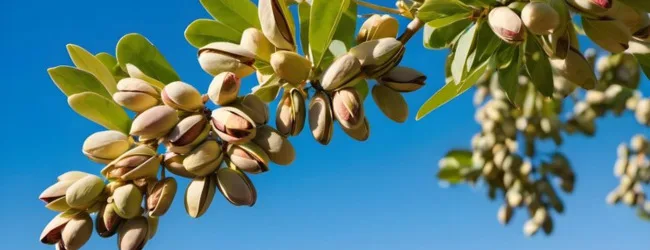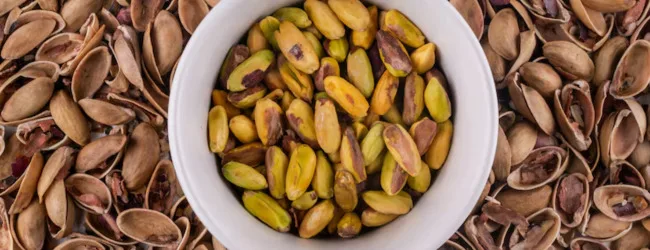Table of contents
Pistachios, those delightful green nuts with a subtly sweet and nutty flavour, are gaining popularity in India. While traditionally grown in regions with colder climates, advancements in agricultural techniques and the introduction of suitable varieties are opening up opportunities for pistachio farming in India. This comprehensive guide will walk you through everything you need to know to embark on this potentially profitable agricultural venture.
Why Consider Pistachio Farming in India?
- Growing Demand: The demand for pistachios in the Indian market is steadily increasing, driven by rising disposable incomes and a growing awareness of their health benefits.
- High Value Crop: Pistachios are a high-value nut, fetching attractive prices in both domestic and international markets.
- Potential for Import Substitution: Currently, India largely relies on imports to meet its pistachio demand, creating a significant opportunity for domestic production.
- Adaptability: New pistachio varieties are being developed that show better adaptability to Indian climatic conditions.
- Long-Term Investment: Pistachio trees have a long productive lifespan, offering a sustainable income source for generations.
Understanding Pistachio Tree Requirements

Before diving into cultivation, it’s crucial to understand the specific needs of pistachio trees:
- Climate: Pistachios thrive in regions with hot, dry summers and cold winters (chilling hours are essential for flowering). However, certain grafted varieties are showing promise in areas with less severe winters.
- Soil: Well-drained, deep, and slightly alkaline loamy soil is ideal. Avoid heavy clay or waterlogged soils.
- Water: While mature trees are drought-tolerant, young trees require regular irrigation. Proper drainage is critical to prevent root rot.
- Sunlight: Pistachio trees need full sun exposure (at least 6-8 hours daily) for optimal growth and nut production.
- Pollination: Pistachio trees are dioecious, meaning they have separate male and female trees. You’ll need to plant both for successful pollination and fruit set. A ratio of one male tree for every 8-10 female trees is generally recommended.
Step-by-Step Guide to Pistachio Farming
1. Land Preparation:
- Clear the land of any weeds, debris, and stones.
- Conduct a soil test to determine the pH and nutrient content. Amend the soil as needed based on the test results.
- Ensure proper drainage by levelling the land or creating drainage channels.
- Mark out planting spots with adequate spacing (typically 6-7 meters between trees).
2. Selection of Planting Material:
- Grafted seedlings are highly recommended over seed-grown plants as they mature and produce fruits much faster and have predictable characteristics.
- Choose varieties that are known to perform well in Indian conditions or are specifically bred for warmer climates. Research and consult with agricultural experts.
- Ensure the seedlings are healthy and disease-free from a reputable nursery.
3. Planting:
- The best time for planting is usually during late winter or early spring.
- Dig pits of appropriate size (around 1x1x1 meter).
- Place the seedling in the centre of the pit, ensuring the graft union is above the soil level.
- Backfill the pit with topsoil mixed with well-rotted manure or compost.
- Water thoroughly after planting.
💡 Pro Tip: If you want to start a farming business but have too many doubts, connect with a farming business expert from Boss Wallah for guidance – Check Out
4. Irrigation:
- Young trees require regular watering, especially during dry periods.
- As the trees mature, reduce the frequency of irrigation but ensure deep watering during critical stages like flowering and nut development.
- Drip irrigation is an efficient method for water management in pistachio orchards.
5. Fertilisation:
- Follow a fertiliser schedule based on soil test results and the tree’s growth stage.
- Generally, nitrogen, phosphorus, and potassium are essential nutrients.
- Apply fertilisers during the active growth periods (spring and early summer).
- Organic fertilisers like compost and vermicompost can also be beneficial.
6. Pruning and Training:
- Regular pruning is crucial for shaping the tree, improving airflow and sunlight penetration, and maximising fruit production.
- Train young trees to develop a strong central leader or a vase-shaped structure.
- Remove dead, diseased, or crossing branches regularly.
7. Pest and Disease Management:
- Pistachio trees can be susceptible to various pests (e.g., aphids, scale insects, psyllids) and diseases (e.g., blight, fungal infections).
- Implement integrated pest management (IPM) strategies, including regular monitoring, biological control, and judicious use of pesticides if necessary.
- Maintain good orchard hygiene to prevent the spread of diseases.
8. Pollination:
- Ensure an adequate number of healthy male trees are planted within the orchard for effective pollination of the female flowers by wind.
- Consider the bloom timing of the male and female varieties to ensure synchronisation.
9. Harvesting:
- Pistachios typically mature in late summer or early autumn (August-October in many regions).
- The hull (outer shell) will start to split open naturally when the nuts are ripe.
- Harvesting can be done manually by shaking the branches or using mechanical shakers in larger orchards.
- Collect the fallen nuts promptly to prevent damage.
10. Post-Harvest Processing:
- Remove the outer hull (de-hulling) within 24 hours of harvest to prevent staining.
- Wash the nuts to remove any debris.
- Dry the pistachios under the sun or using mechanical dryers to reduce moisture content and prevent spoilage.
- Sort the nuts based on size and quality.
- Store the dried pistachios in airtight containers in a cool, dry place.
Setting Up Your Pistachio Farm: The Cost Factor
The initial setup cost for pistachio farming in India can vary significantly depending on several factors, including:
- Land Cost: This is the most variable factor and depends heavily on the location and size of the land.
- Planting Material: Grafted seedlings are more expensive than seed-grown plants but offer significant advantages. Expect to pay anywhere from ₹500 to ₹1500 per grafted seedling.
- Land Preparation: Costs for clearing, levelling, and soil amendment can range from ₹20,000 to ₹50,000 per hectare.
- Irrigation System: The cost of installing a drip irrigation system can vary from ₹80,000 to ₹1,50,000 per hectare, depending on the layout and components.
- Fencing: Protecting the orchard from animals is crucial. Fencing costs can range from ₹50,000 to ₹1,00,000 per hectare, depending on the type of fencing.
- Labour: Initial planting and ongoing maintenance will require labour costs.
- Fertilisers and Pesticides: These are recurring costs that will depend on the orchard size and management practices.
- Equipment: Basic tools and equipment will be needed, and the cost will vary based on the scale of operation.
Estimated Initial Investment (per hectare): Ranging from ₹3,00,000 to ₹7,00,000 or more, excluding land cost. This is a rough estimate and can fluctuate.
Profit Potential in Pistachio Farming

Pistachio trees typically start bearing a significant yield after 5-7 years, with full production reached around 10-12 years. The yield per tree and the market price of pistachios will determine the profitability.
- Yield: A mature, well-maintained pistachio tree can yield anywhere from 5 to 15 kilograms of dry nuts per year, depending on the variety, age, and management practices.
- Market Price: The wholesale price of pistachios in India can range from ₹800 to ₹1500 per kilogram or even higher for premium quality nuts.
Potential Revenue (per hectare): Assuming 200 trees per hectare and an average yield of 8 kg per tree at a price of ₹1000/kg, the potential revenue could be around ₹16,00,000 per hectare per year once the orchard reaches full production.
Profitability: After deducting the annual operational costs (irrigation, fertilisers, pesticides, labour, etc.), pistachio farming can be a highly profitable venture in the long run. However, it’s crucial to factor in the initial investment and the gestation period before significant returns are realised.
Real Business Example: While large-scale commercial pistachio farming is still in its nascent stages in India, individual farmers in regions like Kashmir and Himachal Pradesh, who have adopted suitable varieties and best practices, are reporting promising yields and returns from their small-scale orchards.
ALSO READ | Precision Farming in India: Technology, Benefits & Market Potential
Key Considerations for Success
- Choose the Right Variety: Select varieties that are well-suited to your local climate and soil conditions. Consult with agricultural universities and research institutions for recommendations.
- Focus on Quality: Implement best practices in cultivation, harvesting, and post-harvest processing to ensure high-quality nuts that fetch premium prices.
- Efficient Water Management: Water scarcity can be a concern in many parts of India. Adopt water-efficient irrigation techniques like drip irrigation.
- Pest and Disease Control: Implement proactive and integrated pest and disease management strategies to minimise losses.
- Market Research: Understand the market demand and pricing trends to make informed decisions about selling your produce.
- Patience and Long-Term Vision: Pistachio farming requires patience as it takes several years for the trees to mature and reach full production.
ALSO READ | Top 10 Organic Farming States in India: Organic Hotspots of the Country
Conclusion
Pistachio farming in India holds significant potential for growth and profitability. By understanding the specific requirements of pistachio trees, adopting modern farming techniques, and choosing the right varieties, Indian farmers can tap into the growing domestic demand and contribute to import substitution.
While the initial investment and long gestation period require careful planning and patience, the long-term rewards of pistachio farming can be substantial. Focusing on quality and efficient resource management will be key to success in this emerging agricultural sector.
Frequently Asked Questions (FAQs)
- Can pistachios be grown in India?
Yes, with the right varieties and cultivation practices, pistachios can be grown in certain regions of India, particularly those with hot, dry summers and cold winters, and increasingly in areas with less severe winters due to new varieties. - Which Indian states are suitable for pistachio farming?
Regions in Jammu & Kashmir, Himachal Pradesh, and some parts of Uttarakhand with suitable climatic conditions are currently showing potential. Research is ongoing to identify suitable areas in other states. - How long does it take for a pistachio tree to bear fruit?
Grafted pistachio trees typically start bearing a significant yield after 5-7 years. - How much can I earn from one hectare of pistachio farming?
Once the orchard reaches full production (around 10-12 years), potential revenue can be around ₹16,00,000 per hectare per year, depending on yield and market prices. Profitability depends on managing operational costs. - What is the ideal climate for pistachio cultivation?
Hot, dry summers and cold winters with sufficient chilling hours are ideal. - Do I need both male and female trees to grow pistachios?
Yes, pistachios are dioecious, so you need both male and female trees for pollination and nut production. - How often do pistachio trees need watering?
Young trees need regular watering. Mature trees are drought-tolerant but benefit from deep watering during critical growth stages. - What are the common pests and diseases of pistachio trees?
Common pests include aphids, scale insects, and psyllids. Diseases include blight and fungal infections. - What is the best time to plant pistachio seedlings in India?
Late winter or early spring is generally the best time for planting. - Where can I get grafted pistachio seedlings in India?
Source grafted seedlings from reputable agricultural universities, research institutions, or certified nurseries.


